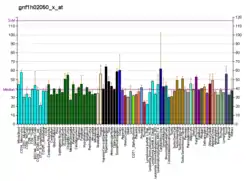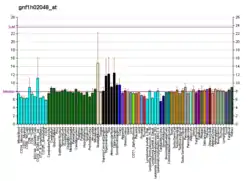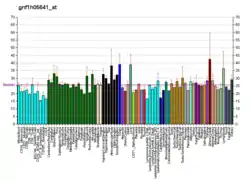PACS1
Phosphofurin acidic cluster sorting protein 1, also known as PACS-1, is a protein that in humans is encoded by the PACS1 gene.[5][6][7]
| PACS1 | |||||||||||||||||||||||||||||||||||||||||||||||||||
|---|---|---|---|---|---|---|---|---|---|---|---|---|---|---|---|---|---|---|---|---|---|---|---|---|---|---|---|---|---|---|---|---|---|---|---|---|---|---|---|---|---|---|---|---|---|---|---|---|---|---|---|
| Identifiers | |||||||||||||||||||||||||||||||||||||||||||||||||||
| Aliases | PACS1, MRD17, phosphofurin acidic cluster sorting protein 1, SHMS | ||||||||||||||||||||||||||||||||||||||||||||||||||
| External IDs | OMIM: 607492 MGI: 1277113 HomoloGene: 9970 GeneCards: PACS1 | ||||||||||||||||||||||||||||||||||||||||||||||||||
| |||||||||||||||||||||||||||||||||||||||||||||||||||
| |||||||||||||||||||||||||||||||||||||||||||||||||||
| |||||||||||||||||||||||||||||||||||||||||||||||||||
| |||||||||||||||||||||||||||||||||||||||||||||||||||
| |||||||||||||||||||||||||||||||||||||||||||||||||||
| Wikidata | |||||||||||||||||||||||||||||||||||||||||||||||||||
| |||||||||||||||||||||||||||||||||||||||||||||||||||
Function
The PACS-1 protein has a putative role in the localization of trans-Golgi network (TGN) membrane proteins. Mouse and rat homologs have been identified and studies of the homologous rat protein indicate a role in directing TGN localization of furin by binding to the protease's phosphorylated cytosolic domain. In addition, the human protein plays a role in HIV-1 Nef-mediated downregulation of cell surface MHC-I molecules to the TGN, thereby enabling HIV-1 to escape immune surveillance.[7]
Clinical significance
A de novo mutation c.607C>T in the PACS1 gene has been shown to result in a syndromic phenotype (colloquially called PACS1 Syndrome) that is characterized by global developmental delay, intellectual disability, and specific facial features.[9][10]
Prevalence and diagnosis
The first two cases were identified in early 2011 by doctors in the Netherlands.[9] As of late 2014, there were 20 cases identified worldwide.[11]
Diagnosis is typically done using full genome or exome sequencing.[12] There are likely several more cases that will eventually be reported as knowledge of the mutation spreads and testing becomes more accessible.
Observed and reported traits
Individuals with the mutation have been reported to have similar facial features, such as:
- Widely spaced eyes and low-set ears
- Down-slanting eye corners and mild uni-brow
- Highly arched eyebrows and long eyelashes
- Rounded “button” nose with a flat bridge
- Wide mouth with down-turned corners
- Thin upper lip and widely spaced teeth
Other common traits reported by care givers of affected individuals are:
- Low muscle tone
- Seizures
- Repetitive self-stimulatory behavior
- Sensory processing disorder
- Delayed development of gross motor skills and fine motor skills
- Delayed cognitive development
- Chewing and swallowing difficulties
- Digestion or bowel problems
- Slow growth resulting in below average height and weight
Prognosis and treatment
In combination, these traits affect walking, talking, feeding, and learning skills. No impact on life expectancy has been found. As with many developmental disabilities, there is no "cure".
In order to improve quality of life and enhance life skills of affected individuals, care givers have found a number of tools and strategies. It is important to note that all of these may not be applicable to a particular individual, and reported effectiveness has varied. It is recommended to consult with a physician prior to initiating any form of treatment.[13]
- physiotherapy (PT)
- occupational therapy (OT)
- speech therapy (including augmentative and alternative communication) (SPT)
- behavioural therapy (applied behavior analysis/intensive behavioural intervention etc.)
- discrete trial teaching
- early intervention programs
- massage therapy and pediatric massage
- feeding therapy
- music therapy
- hippotherapy
- hydrotherapy
References
- GRCh38: Ensembl release 89: ENSG00000175115 - Ensembl, May 2017
- GRCm38: Ensembl release 89: ENSMUSG00000024855 - Ensembl, May 2017
- "Human PubMed Reference:". National Center for Biotechnology Information, U.S. National Library of Medicine.
- "Mouse PubMed Reference:". National Center for Biotechnology Information, U.S. National Library of Medicine.
- Stove V, Naessens E, Stove C, Swigut T, Plum J, Verhasselt B (Oct 2003). "Signaling but not trafficking function of HIV-1 protein Nef is essential for Nef-induced defects in human intrathymic T-cell development". Blood. 102 (8): 2925–32. doi:10.1182/blood-2003-03-0833. PMID 12855553.
- Hinners I, Wendler F, Fei H, Thomas L, Thomas G, Tooze SA (Dec 2003). "AP-1 recruitment to VAMP4 is modulated by phosphorylation-dependent binding of PACS-1". EMBO Reports. 4 (12): 1182–9. doi:10.1038/sj.embor.7400018. PMC 1326413. PMID 14608369.
- "Entrez Gene: PACS1 phosphofurin acidic cluster sorting protein 1".
- Wan L, Molloy SS, Thomas L, Liu G, Xiang Y, Rybak SL, Thomas G (Jul 1998). "PACS-1 defines a novel gene family of cytosolic sorting proteins required for trans-Golgi network localization". Cell. 94 (2): 205–16. doi:10.1016/S0092-8674(00)81420-8. PMID 9695949. S2CID 15027198.
- Schuurs-Hoeijmakers JH, Oh EC, Vissers LE, Swinkels ME, Gilissen C, Willemsen MA, Holvoet M, Steehouwer M, Veltman JA, de Vries BB, van Bokhoven H, de Brouwer AP, Katsanis N, Devriendt K, Brunner HG (2012). "Recurrent de novo mutations in PACS1 cause defective cranial-neural-crest migration and define a recognizable intellectual-disability syndrome". Am. J. Hum. Genet. 91 (6): 1122–7. doi:10.1016/j.ajhg.2012.10.013. PMC 3516611. PMID 23159249.
- Online Mendelian Inheritance in Man (OMIM): 615009
- "Domain Details Page".
- Callaway E (2012). "Gene hunt is on for mental disability". Nature. 484 (7394): 302–3. Bibcode:2012Natur.484..302C. doi:10.1038/484302a. PMID 22517145.
- "Treatment". pacs1.info.
Further reading
- Geyer M, Fackler OT, Peterlin BM (Jul 2001). "Structure--function relationships in HIV-1 Nef". EMBO Reports. 2 (7): 580–5. doi:10.1093/embo-reports/kve141. PMC 1083955. PMID 11463741.
- Leavitt SA, SchOn A, Klein JC, Manjappara U, Chaiken IM, Freire E (Feb 2004). "Interactions of HIV-1 proteins gp120 and Nef with cellular partners define a novel allosteric paradigm". Current Protein & Peptide Science. 5 (1): 1–8. doi:10.2174/1389203043486955. PMID 14965316.
- Joseph AM, Kumar M, Mitra D (Jan 2005). "Nef: "necessary and enforcing factor" in HIV infection". Current HIV Research. 3 (1): 87–94. doi:10.2174/1570162052773013. PMID 15638726.
- Wan L, Molloy SS, Thomas L, Liu G, Xiang Y, Rybak SL, Thomas G (Jul 1998). "PACS-1 defines a novel gene family of cytosolic sorting proteins required for trans-Golgi network localization". Cell. 94 (2): 205–16. doi:10.1016/S0092-8674(00)81420-8. PMID 9695949. S2CID 15027198.
- Hirosawa M, Nagase T, Ishikawa K, Kikuno R, Nomura N, Ohara O (Oct 1999). "Characterization of cDNA clones selected by the GeneMark analysis from size-fractionated cDNA libraries from human brain". DNA Research. 6 (5): 329–36. doi:10.1093/dnares/6.5.329. PMID 10574461.
- Piguet V, Wan L, Borel C, Mangasarian A, Demaurex N, Thomas G, Trono D (Mar 2000). "HIV-1 Nef protein binds to the cellular protein PACS-1 to downregulate class I major histocompatibility complexes". Nature Cell Biology. 2 (3): 163–7. doi:10.1038/35004038. PMC 1475706. PMID 10707087.
- Crump CM, Xiang Y, Thomas L, Gu F, Austin C, Tooze SA, Thomas G (May 2001). "PACS-1 binding to adaptors is required for acidic cluster motif-mediated protein traffic". The EMBO Journal. 20 (9): 2191–201. doi:10.1093/emboj/20.9.2191. PMC 125242. PMID 11331585.
- Williams M, Roeth JF, Kasper MR, Fleis RI, Przybycin CG, Collins KL (Dec 2002). "Direct binding of human immunodeficiency virus type 1 Nef to the major histocompatibility complex class I (MHC-I) cytoplasmic tail disrupts MHC-I trafficking". Journal of Virology. 76 (23): 12173–84. doi:10.1128/JVI.76.23.12173-12184.2002. PMC 136906. PMID 12414957.
- Blagoveshchenskaya AD, Thomas L, Feliciangeli SF, Hung CH, Thomas G (Dec 2002). "HIV-1 Nef downregulates MHC-I by a PACS-1- and PI3K-regulated ARF6 endocytic pathway". Cell. 111 (6): 853–66. doi:10.1016/S0092-8674(02)01162-5. PMID 12526811. S2CID 14835284.
- Scott GK, Gu F, Crump CM, Thomas L, Wan L, Xiang Y, Thomas G (Dec 2003). "The phosphorylation state of an autoregulatory domain controls PACS-1-directed protein traffic". The EMBO Journal. 22 (23): 6234–44. doi:10.1093/emboj/cdg596. PMC 291837. PMID 14633983.
- Beausoleil SA, Jedrychowski M, Schwartz D, Elias JE, Villén J, Li J, Cohn MA, Cantley LC, Gygi SP (Aug 2004). "Large-scale characterization of HeLa cell nuclear phosphoproteins". Proceedings of the National Academy of Sciences of the United States of America. 101 (33): 12130–5. Bibcode:2004PNAS..10112130B. doi:10.1073/pnas.0404720101. PMC 514446. PMID 15302935.
- Köttgen M, Benzing T, Simmen T, Tauber R, Buchholz B, Feliciangeli S, Huber TB, Schermer B, Kramer-Zucker A, Höpker K, Simmen KC, Tschucke CC, Sandford R, Kim E, Thomas G, Walz G (Feb 2005). "Trafficking of TRPP2 by PACS proteins represents a novel mechanism of ion channel regulation". The EMBO Journal. 24 (4): 705–16. doi:10.1038/sj.emboj.7600566. PMC 549624. PMID 15692563.






